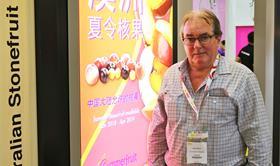
It’s not hard to see why China is the word on the Australian stonefruit industry’s lips.
Having gained direct access to the Asian nation for nectarines in 2016, Australian peaches, plums and apricots were approved for export in late 2017. The opening propelled the industry to its best export performance in over a decade, with 17,785 tonnes of fruit shipped internationally over 2017/18, a 27 per cent increase year-on-year.
China was the leading destination for this trade, receiving 4,985 tonnes of fruit directly, while Hong Kong took 3,308 tonnes.
With the 2018/19 export season getting underway in late November (2018), hopes are high these figures will again be eclipsed.
“Last year we had an exceptional year, our best export year since 2003, and we’re confident we’ll match it,” said John Moore, chief executive of peak industry body Summerfruit Australia.
“It will be the first year of full participation by all summerfruit growers in Australia for exports to China, with fruit primarily coming from Victoria, South Australia and New South Wales.”
To aid market development efforts and showcase the full capabilities of the industry, Australia’s Summerfruit Export Development Alliance (SEDA) – a body that sits within Summerfuit Australia – has developed a concentrated retail programme for the Chinese market.
Backed by a Food Sources grant from the Victorian state government, the programme will see eight Australian growers supply fruit directly to selected retail partners.
After SEDA called for expressions of interest in the programme in mid-2018, the participating growers were selected based on their ability to meet defined quality specifications.
An independent programme facilitator, appointed by SEDA, will conduct inspections upon each consignment’s departure to ensure the quality specifications continue to be met, while there will also be a provision for the Chinese retailers to have the fruit assessed upon arrival.
The programme’s remit isn’t just to highlight the quality of Australian stonefruit; it also aims to bring the category to the forefront of Chinese consumers’ minds.
A wide range of point-of-sale and promotional materials have been developed especially for the programme, while participating growers will send extra fruit to the retailers at no added charge in order to facilitate in-store sampling.
The SEDA programme will operate independently from the established Taste Australia retail programme, which also includes stonefruit promotions.
Ian McAlister, chair of SEDA, said one of the immediate benefits of the programme has been the level of collaboration it has promoted between participating growers. By McAlister's admission, no single Australian exporter has the capacity to deal with a large retailer on their own. By working together, the goal is to drive value growth for the category.
“What they (retailers) demand is consistency of product and the continuous supply of product,” McAlister said. “You can’t come in for one week, send a couple of containers, then be out of the market for three weeks.
“Under this programme, every grower will retain their identity, but if we can get a benchmark standard and consistency it will give the Chinese consumers and retailers the confidence that we can deliver again and again.”
Over 120 Australian stonefruit growers registered to send fruit to China ahead of the 2018/19 season, up from 76 on the year prior, indicating the willingness among the industry to grow this market. With this in mind, provisions have already been made to expand the retail programme.
“It’s been clearly explained to SEDA members that this is a pilot programme to demonstrate to the Chinese retailers that this can work,” Moore explained. “Eventually, as demand grows, we’ll need to source more and more fruit, so other growers will be encouraged to come onboard, providing they can meet the benchmark quality.”
Read more about the SEDA retail programme in the December 2018/January 2019 edition of Asiafruit Magazine, out now.



